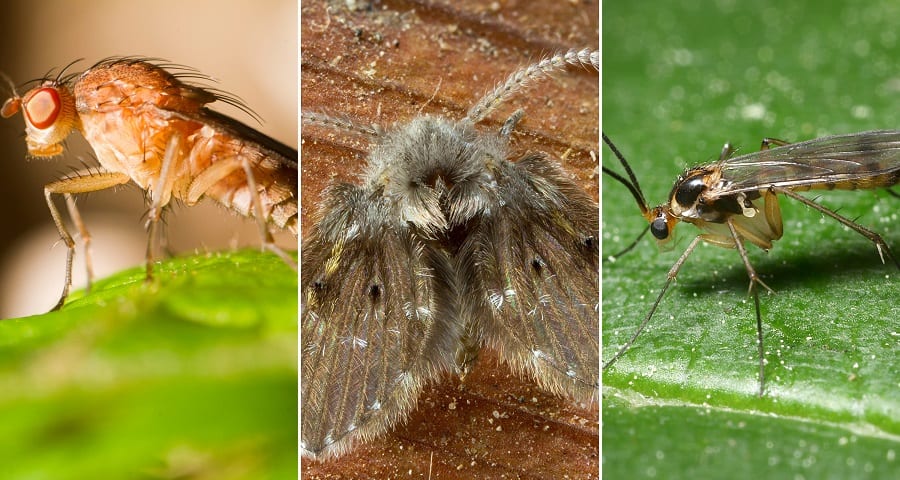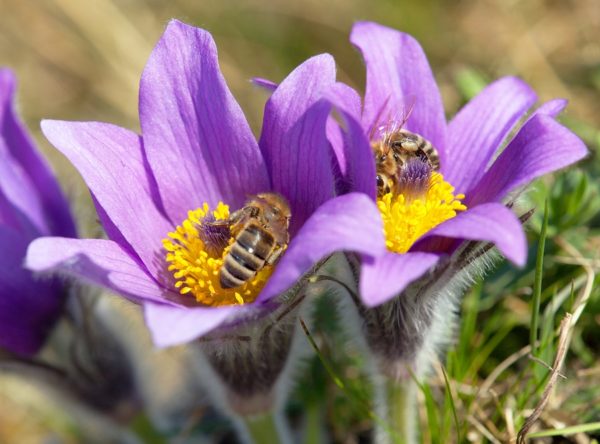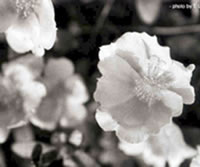READY TO GET STARTED?
REQUEST A FREE ESTIMATE
Fill out the form below or call (888) 466-7849 for a free, no-obligation estimate.

Do you see tiny, flying pests invading your kitchen and the rest of your home? There is a chance that they could be either fruit flies, drain flies, or even gnats. It can be difficult to identify between the three of these, but there are unique characteristics to tell them apart. Identifying them can also be beneficial when trying to prevent them. Let’s break them down.
Fruit flies are the most common flying insects that will pester you in the kitchen. They are attracted to fresh and decomposing fruit, sugary juices, and alcohol. The two most common fruit flies, the red eyed fruit fly and the dark-eyed fruit fly, have striped abdomens. Their eye colors are what give them away.
Some ways to keep fruit flies away are to keep your kitchen and garbage cans clean of any accumulated debris that may attract them. Thoroughly rinse beverage containers, use produce quickly or keep it in the refrigerator, seal garbage cans, and remove trash regularly from the area.
These moth-like, fuzzy pests are commonly found in the kitchen. They thrive in dark, damp conditions and often find an ideal home inside a drain, which can include a floor or sink drain. They don’t bite, but their presence can aggravate asthma in some people. Drain flies appear light gray or tan with a dark border around their wings.
Eliminating drain flies requires a few steps. Once you recognize that you have a drain fly problem, look to tape over the drains and where you suspect they are emerging from and leave it overnight. The next day, check to see if any flies have been collected. If this is the case, your next step is to clean the drain and flush the system.
If you spot a swarm of bugs flitting above a houseplant, you probably have fungus gnats instead of fruit flies. Fungus gnat larva and pupa prefer moist soil to protect them as they develop. Before they progress to adult form, they can severely damage the root system of your potted plants. They have a mosquito-like appearance and are brown or black with light-colored legs.
Preventing fungus gnats should begin with the first houseplant purchase. Look for signs of these pests after purchasing potted plants, and any plant that has gnats already flying around it should be left at the store. It’s also good to be sure your plants aren’t overwatered.
If you have tried all these prevention tips and still think you suspect fruit flies, drain flies, or gnats, then reach out to your local pest control company for more assistance. The professional pest technicians will be able to find the prevention methods that work best for you.

Pollination is when pollen grains are transferred from one flower to another. Pollination allows plants to produce seeds which is how they reproduce. Pollinators are animals and insects that are responsible for helping with the pollination of over 80% of the world’s flowering plants. Animal pollinators are vital in the reproduction of flowering plants and the production of most fruits and vegetables. They accomplish this by getting their food from flowers (think nectar and pollen) and collecting pollen on their bodies in the process. They then move on to another plant and leave the hitchhiking pollen behind, providing the new plants with the pollen they need to reproduce.
Some of the most common animal pollinators that come to mind are bees and butterflies. But did you know there are several other animals you might not have known who are expert pollinators? Here are a few animal pollinators along with the types of plants they pollinate:
Ants love nectar. Because they don’t fly they have to crawl into flowers to get to this nectar. Once inside the flower, pollen sticks to their bodies, allowing them to transfer it to other flowers when they move on. Tropical plants have nectar outside their flowers to attract ants to them. They then use these ants as “protectors” from other insects.
Ants pollinate flowers that:
Bats are known as one of the “night shift” pollinators. They are most common in tropical and desert climates. They are prevalent in the southwest US, Africa, Southeast Asia, and the Pacific Islands as pollinators. In fact, mangoes, bananas, and guavas depend on bats for pollination. In the US and Central America, the agave plant (which is used to make tequila) and the Saguaro cactus are also dependent on bats for pollination.
Bats pollinate flowers that:
Bees are known as the “champion” pollinators and are also the most common. There are over 4000 species of bees in the United States alone. Bees purposefully visit flowers to collect pollen and nectar which they use to feed themselves and their young. Many flowers that bees pollinate have an area of low UV reflection near their centers. Humans can’t see UV reflection so we don’t notice them. Bees, however, use them as a target to guide them to the center of the flower.


Human Perspective Bee Perspective
Photos courtesy of Apalachicola National Forest.
Bees pollinate flowers that:
Beetles were among the first insects to visit flowers. They are important pollinators for ancient species like magnolias. They are known as “mess and soil” pollinators because they eat through flower petals to get to the nectar and then defecate inside the flowers. Fossil records show that beetles were abundant as far back as 200 million years ago.
Beetles pollinate flowers that:
Birds are important pollinators of wildflowers. Hummingbirds are the most important bird pollinators in the United States. In the eastern United States there is only one species that acts as a pollinator and that is the ruby throated hummingbird. Hummingbirds have good eyesight and are extremely attracted to red flowers. They use their long bills to collect nectar and the pollen then dusts their heads and faces.
Hummingbirds pollinate flowers that:
Butterflies are very active during the day. Their body structure doesn’t allow them to pick up as much pollen as bees and other insects but they can see red where bees can’t. Butterflies produce scents that attract other butterflies of the opposite sex. This scent they produce smells like the flowers that they are attracted to.
Butterflies pollinate flowers that:
Two winged pollinators include flies, gnats, and mosquitoes. These insects aren’t as fuzzy as bees so they don’t pick up as much pollen. They are still, however, important pollinators, especially for some species of orchids.
Two-winged insects pollinate flowers that:
Moths are the other member of the pollination “night shift” along with bats. Some moths are also active as pollinators during the day. The yucca plant is one important plant that is dependent on moths for survival.
Moths pollinate flowers that:
Wasps look like bees but have much less hair. This makes them less efficient as pollinators because pollen is less likely to stick to their bodies. Wasps need pollen and nectar for energy. Fig wasps are responsible for pollinating almost 1000 species of figs.
Wasps pollinate flowers that:
There are several other uncommon pollinators. Lizards, geckos, and skinks can be pollinators. They climb inside flowers to drink the nectar and the pollen then sticks to their scales. Lemurs and possums can also pollinate. They use their snouts and tongues to get nectar from plants and then have their faces and snouts dusted with pollen.
We consider most of the animals and insects that are pollinators as nuisances and pests. As much as we don’t want them in our homes, they do play a very critical role in the survival of plants and food. It is important that while we should take steps to prevent them from invading our homes, we should be very careful with how we handle them should they make themselves at home in our area. If you suspect you have a problem with any of these pollinators, contact a professional pest control company who can give you a thorough evaluation and provide you with a treatment plan that both benefits you and protects these important species.